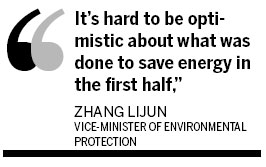Official warns of decline in local green priorities
The Ministry of Environmental Protection warned on Thursday that looser local supervision led to a decline in efforts to control pollution in some parts of the country in the first half of this year.
"It's hard to be optimistic about what was done to cut emissions in the first half," Zhang Lijun, vice-minister of environmental protection, said on Thursday.
"Pollution worsened and supervision loosened in some regions as some local authorities relaxed restrictions on emissions."
The areas most affected were predominantly in the country's west, where local officials had more leeway to use energy and release emissions, said Ma Zhong, dean of Renmin University of China's School of Environment.
If a greater emphasis is not put on reducing emissions, those regions' fast growth will pose dangers to the environment, Ma said.
The central government has already set specific targets for the local governments in terms of energy intensity, or the amount of energy use for each unit of GDP, and for carbon intensity, or the amount of carbon emissions for each unit of GDP.

For instance, the Inner Mongolia autonomous region, Guizhou province and other western regions have been required to reduce their energy intensity by 15 percent by 2015. Jiangsu and Guangdong provinces are meanwhile to reduce theirs by 18 percent.
"Eastern coastal cities are facing more difficulties in attaining their targets," Ma said. "The low-hanging fruits were already picked during the 11th Five-Year Plan period (2006-10).
"Local officials need to place a higher priority on environmental issues, especially those relating to air quality as the public are more aware of such issues at present."
In 2011, the country missed about half of the main targets it had set itself for energy conservation and environmental protection, including its target for energy intensity.
China aims to reduce its emissions of sulfur dioxide - a toxic gas released by power producers and oil and metals plants - and chemical oxygen demand, by 2 percent from a year earlier.
It is also trying to reduce its emission of ammonia nitrogen, which often come from urban sewage, by 1.5 percent this year.
The lingering global recession and domestic efforts to restructure the economy have made the conditions for achieving those goals favorable, Zhang said.
China, to help meet its targets for the entire year, plans to conduct a review of work it undertook to save energy in the first half of 2012, he said.
From 2011 to 2015, China has set the goal of reducing its energy intensity by 16 percent and its carbon intensity by 17 percent.
Reuters contributed to this story.
lanlan@chinadaily.com.cn
(China Daily 07/06/2012 page14)














